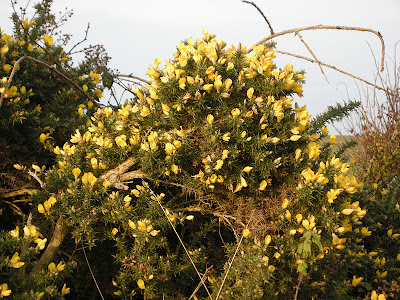If I was a sad lister and kept a 'birds seen from the car' or 'birds seen flying in front of the car' lists then I would have added a new species this week. I was driving home through some lanes towards dusk and as I drove through a flood that was spilling out from a roadside ditch a bird flew in front of the car and in my headlights I could pick out dangling legs and fluttering flight. It flew along in front of the car for a few seconds and then dropped into a gateway and ran into a field. It was a
Water Rail!
It's been cold and windy so far all week and when I called at my feeding station late Monday afternoon it was bitterly cold. In fact there were frequent hail showers blown along with the 25-30 mph wind that made it too unpleasant, and pointless, too have a walk round. All I did was dash down the track and feed.
A couple of
Buzzards were calling and flying along Curlew Wood and
Blackbird numbers at the feeding station had increased to 10. I wondered whether this was possibly because of snowy weather to the north and east pushing birds our way as on some adjacent fields was a flock of 850
Lapwings. As it was late in the afternoon
Tree Sparrows (local name in Yorkshire is Red-headed Sparrow) numbered only 35 with 4 or 5
Chaffinch.
Lapwings
I had a meeting yesterday at Crooklands in south Cumbria and when I could see across to the Howgills they were covered in snow. Very seasonal. Yesterday it looked like there might be a window in the weather to do some ringing on Saturday, but it has all changed now.
I have updated the ringing totals for Fylde Ringing Group in the panel to the right and you will see that we have ringed 4,377 birds of 61 species so far this year. Hopefully we will be able to push the totals over 4,500 by the end of December. It isn't really the totals that matter, more the species and information gained that is important, but the totals give an indication of all the effort that is put in. As usual I have listed the top ten 'movers and shakers' below and as you will see now that we are in winter things are remaining fairly static.
1. Chaffinch - 641 (same position as last month)
2. Meadow Pipit - 414 (same position as last month)
3. Tree Sparrow - 368 (same position as last month)
4. Goldfinch - 357 (up from 5th)
5. Swallow - 330 (down from 5th)
6. Siskin - 260 (same position as last month)
7. Whitethroat - 191 (same position as last month)
8=. Greenfinch - 183 (same position as last month)
8=. Blue Tit - 183 (up from 10th)
9. Lesser Redpoll - 172 (down from 9th)
There were no species that dropped out of the top ten from last month.










































